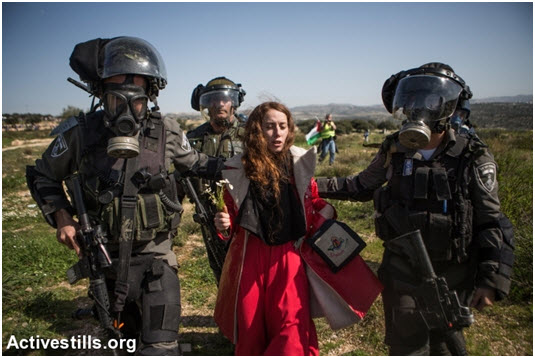Approximately 1,000 protesters, most of them Palestinian, Hadash and Communist Party of Israel members, other Israelis, and dozens of international peace activists took part in a large protest in Bil’in on Friday, February 27, marking ten years of popular struggle against the “apartheid wall” and the occupation of the Palestine lands.
Over the last ten years, Bil’in has become an international symbol of popular, nonviolent resistance to the occupation, the settlements and the separation barrier. By 10 am, members of the Popular Struggle Coordination Committee — which leads the struggle at Bil’in — were joined by committee members from other villages; Israeli Hadash activists; journalists; leading members of the Joint List, MK Dov Khenin (Hadash) and candidate in the next elections Aida Touma-Sliman (from the Communist Party) and a member of the Palestinian Legislative Council, Mustafa Barghouti.

Israeli border policemen arrest a Hadash activist protester during the demonstration marking ten years of popular struggle against in the West Bank village Bil’in, February 27, 2015. (Photo: Activestills)
The march to the separation wall began shortly after noon, using the same route the residents have taken week after week for the past decade. The original separation fence kept some 1,950 dunams (480 acres) of Bil’in’s land on the Israeli side, for the purpose of expanding the Modi’in Illit settlement. However, Israel’s Supreme Court ruled that the fence must be moved, and after four years of waiting, the Israeli government built a new wall that “only” encloses some 1,300 dunams (320 acres) of the village’s land.
Friday’s protest was lead by a group of Palestinian scouts, who carried Palestinian flags and drums. They were followed by the demonstrators, who sang songs and chanted against the wall, the settlements and the occupation. In contrast to previous weeks, when Israeli soldiers greeted the protesters and tried to thwart the demonstration at the site of the old route of the fence, this time soldiers waited behind the new wall. They began firing tear gas as the first demonstrators approached the wall.
As Bil’in marked ten years of popular struggle, dozens of Palestinians, Israelis and international peace activists protested in the heart of Hebron, marking 21 years since Baruch Goldstein massacred 29 Muslim worshippers in the Ibrahimi Mosque (known in Israel the “Cave of the Patriarchs”). Ever since the massacre, the Israeli army has severely restricted the movement of Palestinians in the city. The goal of the demonstration was to reach and demand the opening of Shuhada Street, which previously served as a main road and central economic hub of the city. The protest was organized by the Youth against Settlements group, as well as by the Committee to Save Hebron, which is made up of different left-wing Palestinian political parties in the city. Three Palestinians were injured by live bullets and dozens suffered excessive tear gas inhalation during a protest in the city of Hebron. Local sources told the Ma’an news agency that Israeli forces suppressed a demonstration of Palestinians who were demanding Israeli authorities reopen Shuhada street, once a major thoroughfare in Hebron’s Old City. The three who were shot with live bullets were identified as Abd al-Majid Amro, Issa Mahmoud Amro, and Anas Amro. Israeli soldiers also arrested three youths. Protesters chanted slogans against the Israeli occupation and settlements, and against Prime Minister Benjamin Netanyahu’s upcoming visit to Hebron and the Ibrahimi Mosque.
Meanwhile, in Kafr Qaddum near Nablus, on Friday a photojournalist who works for Reuters was hit in the neck by an Israeli tear gas grenade. Murad Ishtewi, the coordinator of the popular resistance committees in Kafr Qaddum, told Ma’an that Israeli soldiers opened fire and shot tear gas canisters, injuring Reuters photojournalist Abd al-Rahman al-Qussini. Dozens of Palestinians suffered from tear-gas inhalation and faintness and were treated on the spot by the Palestinian Red Crescent, he said. The marchers chanted slogans calling for the boycott of Israeli products. The march was organized under the title: “Do not pay for the bullets that kill you and the gas that suffocates you.” It came amid a series of activities organized by the Fatah movement calling for boycott.
Protests are held every Friday in Kafr Qaddum against Israel’s closure of a main road linking the village to its nearest city, Nablus. On Saturday, February 28, three Palestinians were injured with rubber-coated steel bullets while dozens of others suffered from tear-gas inhalation during clashes near the Attara checkpoint north of Ramallah. Clashes erupted with Israeli soldiers when dozens of Palestinian youths headed toward the checkpoint. Israeli forces opened up with live fire, rubber-coated steel bullets, tear-gas grenades, and stun grenades to disperse the youths who responded by throwing rocks.


